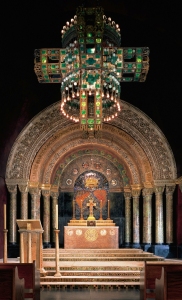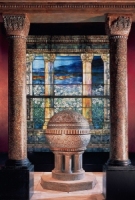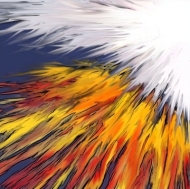A Chapel of Glass
| |  | | | Tiffany Chapel, c. 1893,
Louis Comfort Tiffany,
Morse Museum of Art
(Photos courtesy of the Morse Museum of Art, Winter Park, Florida.) | | | | Most people associate stained glass with the colorful windows found in churches. And the name most widely associated with stained glass is Louis Comfort Tiffany. Now imagine a chapel built almost entirely of glass and that is exactly what Tiffany built in 1893. Originally constructed for the 1893 World Columbian Exposition in Chicago, the chapel was the centerpiece for a display of work from the Tiffany Studio. The 800-square-foot chapel included an altar of marble decorated with glass mosaic backed by a stained glass reredos. Sixteen columns and six arches were inlaid with semi-precious stones, glass mosaics, and scrollwork. There was a glass mosaic baptismal font mounted on columns with a backdrop featuring a stained glass window with four elaborate columns. There were four additional stained glass windows and a 10-foot-high emerald glass cross chandelier (electrified). The chapel brought Tiffany international attention and 54 awards. After the exhibition, Celia Whipple Wallace purchased the chapel and donated it to the Cathedral of St. John the Divine that was under construction at the time in New York City. But the chapel was never installed as it was intended. Ralph Adams Cram took over the cathedral project as architect and decided the cathedral's style would be entirely Gothic and relegated the Byzantine style chapel to a cramped space in the basement where the towering chapel had to be modified. Following the death of Wallace and after ten years at St. John the Devine, the chapel was no longer in use and in deteriorated condition. Tiffany offered to remove the chapel at his expense and installed it in a free-standing building at his Long Island estate, Laurelton Hall, where he repaired the damage and replaced the Celtic altar cross that had disappeared. After Tiffany's death in 1933, his estate, including the chapel, became part of the Tiffany Foundation. But after years of mismanagement, the foundation had dismantled the chapel and sold portions of it. A devastating fire in 1957 would destroy the mansion although what was left of the chapel was spared. Tiffany patrons, Hugh and Jeannette Genius McKean, were asked if they would salvage some of the stained glass windows from the house. Many of the windows and architectural details were saved, and two years later the McKean's bought the remains of the chapel. They would then spend years tracking down the missing pieces of the chapel. Thanks to their devotion, the Tiffany Chapel has now been restored and reassembled at the Morse Museum of American Art in Winter Park, Florida, where the general public can again view what many consider Tiffany's greatest achievement. It was said that when people at the 1893 Exposition visited the Tiffany Chapel, they were so moved emotionally, that they would fall silent and men would remove their hats upon viewing the chapel. Now the chapel can once again be seen as Louis Comfort Tiffany originally envisioned it more than a century ago.  | | | Tiffany Chapel Baptistery | | For more photos of the Tiffany Chapel, please visit page 2 at the ECVA website by clicking here.
The Morse Museum of Art
445 Park Avenue North
Winter Park, Florida 32789
(407) 645-5316
www.morsemuseum.org Dan Hardison
Editor, The Episcopal Church and Visual Arts
editor@ecva.org | 


